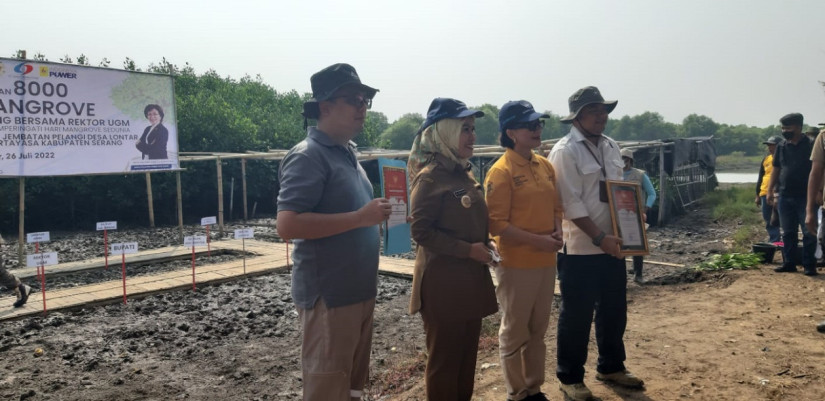
A cinematographic video titled Planting the Future: Mangrove Rehabilitation, created by UGM’s KKN-PPM students in Serang, Banten, has been awarded Intellectual Property Rights (IPR) under the registration number EC00202485523.
This achievement marks the culmination of a long journey undertaken by the UGM KKN-PPM students in Serang, Banten, over several periods.
Dr. Sudaryatno, the field supervisor who has guided the KKN students in Serang for five periods, explained that the video documents the management of the mangrove ecosystem in Serang Regency.
The video takes viewers through a 15-year journey of challenges and successes in managing the mangrove ecosystem in the area.
“This video presents an overview of the mangroves in Serang from 2009 to 2024, showing the initial conditions marked by degradation and deforestation due to land conversion and overexploitation,” said Dr. Sudaryatno at the UGM Faculty of Geography on Tuesday (Aug. 20), responding to the news of the video receiving IPR.
Dr. Sudaryatno further elaborated that due to the alarming condition of the mangroves at that time, stakeholders embarked on various efforts to restore and preserve the ecosystem. Over the years, UGM’s KKN activities in Serang have consistently included mangrove reforestation programs.
“Additionally, we have been advocating for regulatory policies and empowering coastal communities to manage mangrove forests,” he added.
The IPR recognition was achieved during the fourth period of UGM’s KKN-PPM program in Serang, Banten, from December 2023 to February 2024.
Alongside the video, the students produced a report titled KKN-PPM Program Report Period IV 2023: Mapping Aboveground Carbon Stock in Mangrove Areas of Pontang, Tirtayasa, and Tanara.
The mangrove forests in Serang, found along the northern coast, specifically in Pontang, Tirtayasa, and Tanara districts, have significant economic, ecological, and socio-cultural impacts.
These forests are crucial for mapping aboveground carbon stock, which is a foundation for sustainable monitoring and conservation efforts.
“The importance of mapping aboveground carbon stock is heightened by the worsening climate conditions, making it increasingly difficult for mangroves to adapt to fluctuating environmental conditions,” he explained.
Dr. Sudaryatno narrated how massive mangrove planting began in 1989 and peaked in 2024. Anyone with access to seedlings can carry out mangrove planting daily.
According to Dr. Sudaryatno, the mangroves in the eastern Pontirta area, affected by coastal erosion, are crucial for protecting against erosion. The current mangrove buffer zone in Lontar Village is only 25 meters wide, while the ideal width is 100 meters to prevent severe abrasion.
“Therefore, expanding mangrove areas is essential,” he emphasized.
However, expanding mangrove areas is not easy due to challenges such as the degradation of mangrove lands into built-up areas, particularly for industrial purposes. This situation complicates efforts to increase mangrove land area, which is compounded by land status issues.
“The mangroves in Tanara are extensive, but many have been converted into fish ponds, making this a critical concern. Recently, mangrove management has focused on maintenance, especially against threats like waste pollution. He explained that government involvement is needed to expand mangrove areas, particularly by establishing coastal spatial planning to preserve mangroves in the Pontirta region,” he explained.
Dr. Sudaryatno added that the video, which received IPR, highlights successes and presents the challenges and obstacles faced in mangrove management efforts.
The video showcases how climate change, coastal erosion, and environmental pollution threaten mangrove’s sustainability.
“In the end, the video prompts us to reflect on the future of mangroves in Serang Regency. It is hoped that this video will inspire and educate the public and recognize the efforts of stakeholders in synergistically protecting and managing the mangrove ecosystem in Serang Regency,” he concluded.
Author: Agung Nugroho

